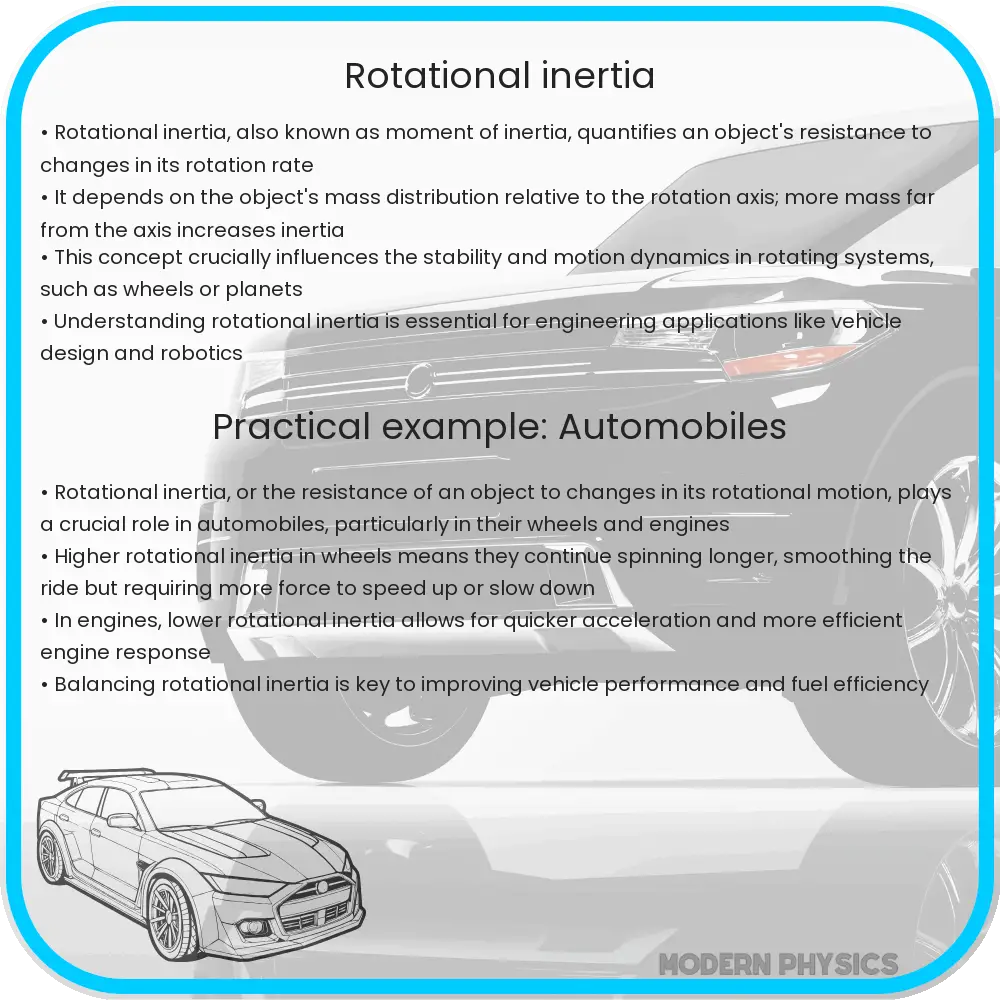Rotational Inertia (moment of inertia) measures the resistance of an object to changes in its rotational motion around an axis.

Understanding Rotational Inertia: The Basics of Spinning
Rotational Inertia, also known as moment of inertia, plays a crucial role in the dynamics of rotating objects. It is the rotational equivalent of mass in linear motion. Specifically, it is a property that measures the difficulty in changing the state of rotation of an object about an axis. This concept is pivotal in various fields, from engineering mechanics to aerospace technology.
What is Rotational Inertia?
Rotational Inertia (I) of an object depends on the mass distribution relative to the axis of rotation. The further the mass is distributed from the axis, the higher the rotational inertia. For example, a solid disk will have a different moment of inertia compared to a hollow cylinder of the same mass and radius, due to the differences in how mass is distributed relative to the axis.
Mathematical Formulation
The mathematical expression for rotational inertia when considering point masses is given by:
I = Σmiri2
where mi represents the mass of the ith point, and ri is the distance of the mass from the axis of rotation.
For continuous bodies, the summation turns into an integral:
I = ∫r2dm
Here, dm represents an infinitesimal element of mass at a distance r from the axis of rotation.
The Role of Torque in Rotational Motion
Torque (τ) is the rotational equivalent of force in linear motion. It is calculated by taking the cross product of the position vector (r) and the force vector (F), resulting in:
τ = r * F * sin(θ)
where θ is the angle between the position vector and the force vector. Torque influences how rapidly an object changes its rotation, which is directly proportional to the rotational inertia. The relation linking torque, rotational inertia, and angular acceleration (α) is expressed as:
τ = I * α
This equation is analogous to Newton’s second law (F = ma) in rotational dynamics.
Calculating the Effects of Rotational Inertia in Motion
When you apply torque to an object, how it reacts depends largely on its rotational inertia. For instance, when you push at the edge of a door, it rotates about its hinges. The amount of force needed to achieve a certain angular acceleration becomes greater as the rotational inertia increases. This is because more energy is required to change the rotation of objects with higher moments of inertia.
- The same principle applies to wheels of vehicles: wheels are intentionally designed with suitable moments of inertia to optimize their performance based on expected usage.
- In sports, the moment of inertia of equipment like golf clubs and baseball bats affect their performance and the athlete’s ability to control them.
- In space, the moment of inertia of satellites determines the effectiveness of attitude control systems necessary for orienting the satellite properly.
Practical Applications in Everyday Life
The importance of understanding and managing rotational inertia can be seen in everyday objects and activities. The wheels on grocery carts, for instance, have minimal rotational inertia making them easy to pivot and turn. In contrast, flywheels used in engines store rotational energy based on the principles of high rotational inertia, allowing them to smooth out the operation of the engine by maintaining a consistent speed during operation.
Impact on Renewable Energy
Rotational inertia also plays a significant role in renewable energy systems, such as in wind turbines. Large wind turbines have blades that act like aerofoils, and their rotational inertia helps stabilize the turbine’s electricity generation in variable wind conditions. Proper design and calculation of rotational inertia ensure that these systems are both efficient and durable over time.
Conclusion
From the spinning of a hard drive in your computer to the functioning of complex spacecraft systems, rotational inertia is a fundamental aspect of countless mechanisms and technologies. Understanding the concept of rotational inertia not only enhances our grasp of physics but also enables engineers and designers to optimize the functionality and efficiency of various mechanical devices and systems. The ability to apply principles such as torque and rotational inertia in practical situations can vastly improve the performance of devices and the development of technologies for future innovation. Ultimately, the study of rotational inertia bridges the gap between theoretical physics and practical engineering applications, making it essential for anyone interested in understanding and improving the mechanical and dynamic systems that surround us.
